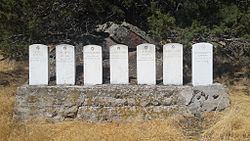Reference no. 16 | ||
 | ||
Location Near Likely, California | ||
Freedoom 0 11 phase 1 e3m2 infernal caverns uv all secrets 1080p 60fps
Infernal Caverns is the site of an 1867 battle between U.S. armed forces and Shoshone, Paiute, and Pit River Indians. Infernal Caverns Battleground is California Historical Landmark No. 16.
Infernal Caverns, also known as Hell Caves, is located 6.5 miles west of Likely, California, and 1 mile south of the Ferry Ranch in Modoc County, California. The Infernal Caverns Battleground was the site of one of the last Indian battles fought in California, on September 26–27, 1867.
United States Army General George Crook was sent west to quell Indian uprisings that had begun in 1848 when the Northern Paiutes, related to the Shoshone tribe, bitterly attacked and killed European-Americans. The last incident that had brought U.S. Army action was when marauding Indians killed 78 miners that were en route to Colorado.
With the 39th Mounted Infantry, General Crook tracked the Indians south from Goose Lake (which lies on what is now the California-Oregon border), engaging them in a desolate spot named Infernal Caverns. The two-day battle began high in a canyon covered with giant boulders, rocky caverns, and hollow fumaroles caused by lava flows. Eight soldiers were killed in action. Six were buried at the site, and a seventh, Sgt. David Rustler, was transported by double mule travois to Camp Warner at Goose Lake, where he died a few days later. Lt. John Madigan, the only officer killed in the fight, was buried just outside the town of Alturas, California. Six white marble tombstones were erected by the U.S. government to mark the burial location for the soldiers. One additional tombstone was added in 1995 for Private Willoughby Sawyer, who also died in this battle and whose marker was missing. This historical omission was discovered by California historian Chris J. Wright.
